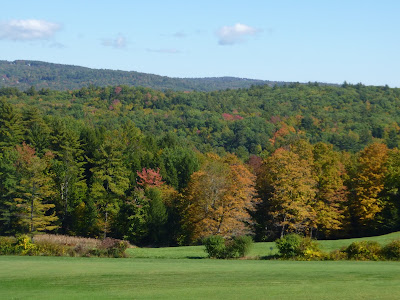 |
| Very old olive trees in St-Remy |
Okay, I'm going to make a list of things I totally respond to and, no, it's not a long list.
- A picnic of fresh bread, cheeses, and wine laid out in some herbaceous countryside where one can sit in the sun, listen to the cicadas, and take in the warmth and fresh air.
- Olives, of course. Lots of olives.
- Sunshine and blue skies.
- The scent of lavender.
- Outdoor markets with more fresh bread, more fresh cheeses, and bins of more olives all set out by people who love their work and wouldn't want to be doing anything else.
- The feeling that life is good, as a result of the above.
Such simple pleasures, yet it seems as if there's only one place that takes them to heart and knows how to do them to perfection. And that is France. At any rate, I find myself picking up book after book about France--its style, its wonders, its peculiarities. I do love it there. I tried spending some winter weeks there nearly ten years ago hoping to come away able to speak the language after taking daily classes. But my brain became saturated very quickly and by the time I got home again, I put away all thoughts of speaking French. (Should have learned it before I was eleven, I told myself, not at sixty-something.)
 |
| Arles |
At any rate, I find myself favoring books about France. Right now, as it happens, I'm in the process of reading two. One is
Pardon My French, How a Grumpy American Fell in Love with France, by Allen Johnson. The other is
The Only Street in Paris, Life on the Rue des Martyrs by Elaine Sciolino.
Looking through my bookshelf, I find several I can recommend:
Polly Platt,
French or Foe, Getting the Most Out of Visiting, Living, and Working in France. (Lots of good practical info. For instance, it's important to understand that the French rank both wit and liberty HIGH on their lists.)
The English actress, Carol Drinkwater who's lived in Provence for years, has written several including, 1)
The Olive Farm, A Memoir of Life, Love, and Olive Oil in the South of France, and
2)
The Olive Season, Amour, A New Life, and Olives, Too ...!
Of course, there's Peter Mayle, the Englishman, with his now-classic,
A Year in Provence, plus
Toujours Provence. I think I've also read all of his fiction set in France--all light, fun reading.
 |
| Avignon |
Then there's:
Sarah Turnbull,
Almost French, Love and a New Life in Paris (about what makes the French tick).
Ellie Nielsen,
Buying a Piece of Paris, A Memoir. (An Australian family buy an apartment.)
And food books:
Luke Barr,
Provence, 1970, M.F.K.Fisher, Julia Child, James Beard, and the Reinvention of American Taste.
David Lebovitz
, The Sweet Life in Paris, Delicious Adventures in the World's Most Glorious--and Perplexing--City. (With recipes.)
Karen Le Billon,
French Kids Eat Everything, How Our Family Moved to France, Cured Picky Eating, Banned Snacking, and Discovered 10 Simple Rules for Raising Happy, Healthy Eaters. (Should be required reading.)
Of a different nature, there's
A Life of Her Own, the Transformation of a Countrywoman in Twentieth-Century France, by Emilie Carles (1900-1979) who was born into a peasant community in the high Alps and tells about, as the jacket says, "a world that has largely disappeared ... and the one that has emerged to take its place." For me, a keeper.
As is Simone de Beauvoir's (1908-1986) four-volume autobiography: 1)
Memoirs of a Dutiful Daughter, 2)
The Prime of Life, 3)
Force of Circumstance, and 4)
All Said and Done. (Note: sometimes the third volume is divided into two separate books: 1)
After the War and 2)
Hard Times.)
Then, another American author, the wife of a Frenchman and mother of two children who tease her about her accent, has a book about French words,
Words in a French Life, Lessons in Love and Language from the South of France, by Kristin Espinasse.
 |
| Near the square in the city of Nice. Check out that blue sky! |
While we're sticking with non-fiction books, I'm going to add Marcel Pagnol's reminiscences about his childhood in Marseilles and the Provençal countryside
--My Father's Glory and
My Mother's Castle. (Both books are published in one volume unless you're buying French editions.) (You may remember the exquisite movies by the same name.)
So I've just gone down to my bookstore and ordered a copy.
(Though it's a work of fiction and these others aren't, one current book I do not recommend is
The Little Paris Bookshop by Nina George which has a good premise--prescribing books for people's ailments--but is predictable and cliched.)
So, with July coming up, I'm devoting this posting to France. There is, of course, July 14th, Bastille Day. But I also want to mention July 1st, the hundredth birthday of one of my favorite actresses: Olivia de Havilland who has lived in Paris more than half her life.
























































